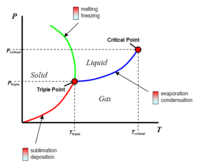Difference between revisions of "Terraforming"
(Pioneer Organisms) |
|||
| Line 9: | Line 9: | ||
==Methods== | ==Methods== | ||
A life supporting atmosphere needs to contain a "buffer gas", such as nitrogen. Mars is currently lacking in nitrogen, but nitrogen could be sourced from Venus, Saturn's moon Titan, or from comets. | A life supporting atmosphere needs to contain a "buffer gas", such as nitrogen. Mars is currently lacking in nitrogen, but nitrogen could be sourced from Venus, Saturn's moon Titan, or from comets. | ||
| − | Mars could be warmed up using greenhouse gases such as perflurocarbons, which are stable in the atmosphere for long periods of time. Mirrors could be placed in orbit to increase the amount of insulation Mars receives. | + | Mars could be warmed up using greenhouse gases such as perflurocarbons, which are stable in the atmosphere for long periods of time. Mirrors could be placed in orbit to increase the amount of insulation Mars receives. |
| + | |||
| + | Other greenhouse gasses include sulfur hexafluoride and 1,1,1-Trichloro ethane. These are very stable and highly effective greenhouse gasses. Use of such gasses to warm the atmosphere would allow the Carbon dioxide frozen into the polar caps and some of the water to evaporate adding to the mass of the atmosphere. If one tenth of the atmosphere comes from manufactured dense greenhouse gasses and nine tenths from gasses released by warming and the atmospheric pressure is brought up to one tenth of a Earth sea-level pressure, then a mass of manufactured greenhouse gasses equal to about one-hundred-seventy times the cargo capacity of the Edmund Fitzgerald every hour for a thousand years would be required for the project. | ||
==Pioneer Organisms== | ==Pioneer Organisms== | ||
Revision as of 08:45, 7 September 2010
Terraforming, or Earth-shaping, is a theoretical process of modifying a planet's atmosphere to make it habitable for humans. In the case of Mars, terraforming would require artificial thickening of the atmosphere to intensify the process of greenhouse warming (heating the frozen landscape), ice melting to increase the H2O content of the atmosphere (creating water clouds) and greatly increasing the O2 density to ultimately make the atmosphere breathable.
Mars and the "Triple Point" of water

Presently, ice on Mars sublimes as the atmospheric pressure is so low, ice bypasses the liquid phase when heated. Sublimation occurs allowing ice to turn directly into gas (steam). One of the main challenges for future terraforming efforts would be to increase the atmospheric pressure significantly so water can exist as a liquid on the surface of Mars. The atmospheric pressure will therefore need to be greater than the triple point of water (thereby existing as ice, liquid and gas).
Methods
A life supporting atmosphere needs to contain a "buffer gas", such as nitrogen. Mars is currently lacking in nitrogen, but nitrogen could be sourced from Venus, Saturn's moon Titan, or from comets. Mars could be warmed up using greenhouse gases such as perflurocarbons, which are stable in the atmosphere for long periods of time. Mirrors could be placed in orbit to increase the amount of insulation Mars receives.
Other greenhouse gasses include sulfur hexafluoride and 1,1,1-Trichloro ethane. These are very stable and highly effective greenhouse gasses. Use of such gasses to warm the atmosphere would allow the Carbon dioxide frozen into the polar caps and some of the water to evaporate adding to the mass of the atmosphere. If one tenth of the atmosphere comes from manufactured dense greenhouse gasses and nine tenths from gasses released by warming and the atmospheric pressure is brought up to one tenth of a Earth sea-level pressure, then a mass of manufactured greenhouse gasses equal to about one-hundred-seventy times the cargo capacity of the Edmund Fitzgerald every hour for a thousand years would be required for the project.
Pioneer Organisms
Certain organisms, such as archaea, lichen, and tardigrades have been proven capable of surviving extreme environments, such as the vacuum of space. They could gain a foothold on the martian surface after minimal terraforming. The byproducts of their metabolism would contribute to the terraforming efforts.
Long term prospect
The ultimate results of terraforming are disputed. Terraforming may have only a temporary effect, even if the effect lasts for some hundred or thousand years. Eventually, the solar wind may carry away most of the new atmosphere due to the insufficient magnetic fields of Mars.






